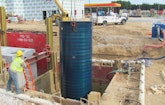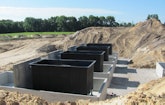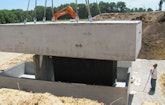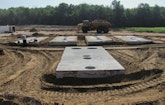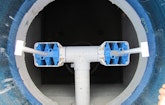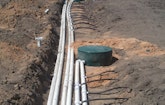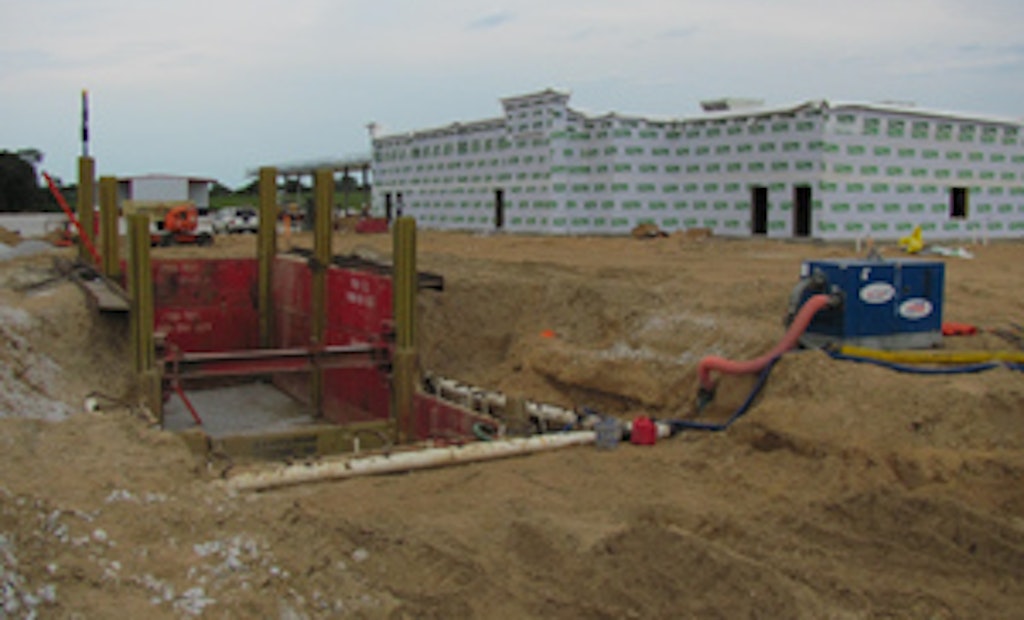Interested in Systems/ATUs?
Get Systems/ATUs articles, news and videos right in your inbox! Sign up now.
Systems/ATUs + Get AlertsA privately held company wanted to build a travel plaza at Interstate 65 and Indiana 10 just south of DeMotte, Ind. Plans called for a 10,000-square-foot travel center, convenience store, full-service restaurant, and showers for truck drivers.
Scott Rexroth of Clear Water Environmental Systems in Noblesville, Ind., and Chris Badger, P.E., of Badger Engineering & Associates in Lebanon, Ind., subcontracted to design and install an onsite system to handle high-strength waste for site work contractor Site Masters Construction of Maben, Miss.
“This was a high-profile large commercial development for the county,” says Badger. “The permitting process took time, even though the state Department of Health told us what type of system and absorption bed to install and where to put the drip field.” Badger and Rexroth chose the products.
Permit acquisition, heavy spring rains, a seasonal high water table, coordination with contractors, and plan alterations on site challenged Rexroth and his crew as they faced an aggressive construction schedule. The plaza opened on time last September.
Site conditions
Soils are sandy loam and fine sand with a loading rate for highly treated effluent of 0.6 gallons per square foot per day. The seasonal high water table is 12 inches below grade. The plaza, on 15 acres, is on a freeway interchange.
System components
Badger sized the system to handle 10,000 gpd at a waste strength of 1,200 mg/l BOD per day. Its major components are:
2,000-gallon concrete grease interceptor with traffic-rated lids and cast-iron risers. All tanks made by Oldcastle Precast.
6,400-gallon septic tank with two Polylok 10,000 gpd PL-525 effluent filters
72-inch-diameter by 216-inch-deep prepackaged fiberglass lift station with duplex Zoeller single-phase 50 gpm sewage pumps
15,000-gallon concrete tank with 6,000-gallon settling compartment and 9,000-gallon flow equalization compartment with four Zoeller single-phase 30 gpm effluent pumps
Four 15,000-gallon concrete tanks in parallel with 9,000-gallon compartments for High Strength FAST 9.0 aerobic treatment units from Bio-Microbics and 6,000-gallon dosing compartments with a Zoeller single-phase 30 gpm turbine pump
Four custom supply-and-return valve boxes with pressure gauges, shut-off valves, check valves, and solenoid valves
16,800 feet of Geoflow drip irrigation tubing in four zones
Four custom control panels from SPI – Septic Products
System operation
Most plumbing is 6-inch Schedule 40 PVC pipe. The wastewater gravity main and discharge from the grease interceptor enter the septic tank, and from there effluent flows into the lift station. On-demand alternating pumps send the liquid to the settling/flow equalization tank.
Every 11.5 minutes, dedicated pumps in the equalization compartment run for 3.5 minutes, sending 105 gallons through 2-inch pipes to each treatment unit. Badger chose the FAST systems because they require little maintenance, handle fats, oils, and grease, and reduce BOD and TSS to less than 30 mg/l with 65 percent nitrogen reduction.
Rexroth custom-built valve boxes to dose the dispersal field zones in any possible combination, allow resting of zones if necessary, and allow easy field expansion. Each zone has 24 runs at 175 feet on 1-foot centers. Zones 1 and 2 have an independent control panel, as do zones 3 and 4.
“We’re dealing with specific flow rates and numbers of lines with only one pump per zone,” Rexroth says. “It requires custom valve boxes to make sure we get the proper operation and can disperse enough effluent.”
The one-half-gallon-per-hour emitters on the drip tubing drain into the soil. The 2-inch supply manifolds drain back through the supply valve boxes to the dosing tanks. The 2-inch return manifolds drain through the return valve boxes, then tie into a 4-inch line routed back to the flow equalization tank to prevent water from freezing in the pipes.
Installation
The Department of Health located the dispersal field in an outwash moraine to keep it away from the development. At the preconstruction meeting, Badger and Rexroth noticed that the moraine was very wet, although it was all sand. “We talked to the guys working at the site, and they said the area had recently been under two feet of water,” says Rexroth. “Whoa! Time out. We’re not putting our field there.”
A wooded sand dune 15 feet higher in elevation than the moraine and about 200 feet away seemed a better alternative. The men asked Dave Ortel, a Department of Health representative and registered soil scientist, for permission to move the dispersal field. He agreed and did the soil work that day.
Rexroth coordinated with Mike Earley, project manager for Site Masters, on when to excavate the tank holes and set the tanks. “Pipe slope elevations dictated that we set the septic tank at an elevation that precluded flow by gravity, which is why we needed a lift station pumping to the flow equalization tank,” says Rexroth.
The deep excavations required severe trench box work and constant dewatering. Earley added 12 inches of gravel to bed the tanks and poured a 24-inch-thick concrete anti-flotation collar around the lift station. He returned to unload and set the 33-ton bottom halves of the tanks when they arrived, then placed the 32-ton upper halves after Rexroth installed and plumbed the treatment units and lift station.
“We coordinated every move with Mike, even the backfilling, so we both worked as efficiently as possible,” says Rexroth.
That coordination extended to Earley removing trees from the dispersal field site, scarfing sand to lower the elevation, and contouring the dune. “Roots weren’t a problem because the sand enabled Mike to pull out most trees by the roots,” says Rexroth. “On the other hand, we had to plan how Brian Baker of Baker Construction in Noblesville was going to pull through the drip tubing without sinking his walk-beside LM-42 Vermeer vibratory three-shank plow.”
Another challenge was dispersing 10,000 gpd in the small field. “If we installed tubing on 2-foot centers with a half-gallon-per-hour emitter every two feet, the pumps would run nonstop,” says Rexroth.
Rexroth conferred with Badger, who suggested adding six inches of topsoil for traction, then knifing in three lines on 1-foot centers six inches deeper than originally planned to take advantage of the sand’s higher loading rate. Baker also added a second set of wheels to distribute the weight of the machine better.
“The modifications sound easy today, but they were real obstacles when faced with a fast-approaching deadline,” says Rexroth. “In the end, we finished the installation on schedule.”
Maintenance
Sewer or Septic Services in Noblesville holds the maintenance contract. Quarterly, two technicians check sludge levels, clean the effluent filters, test the pumps and float switches, clean the air filters on the blowers, observe the treatment media, flush the drip field, and pull effluent samples for BOD, TSS, pH and temperature.

